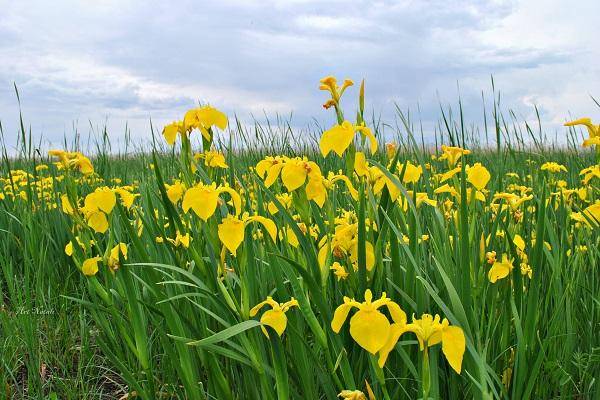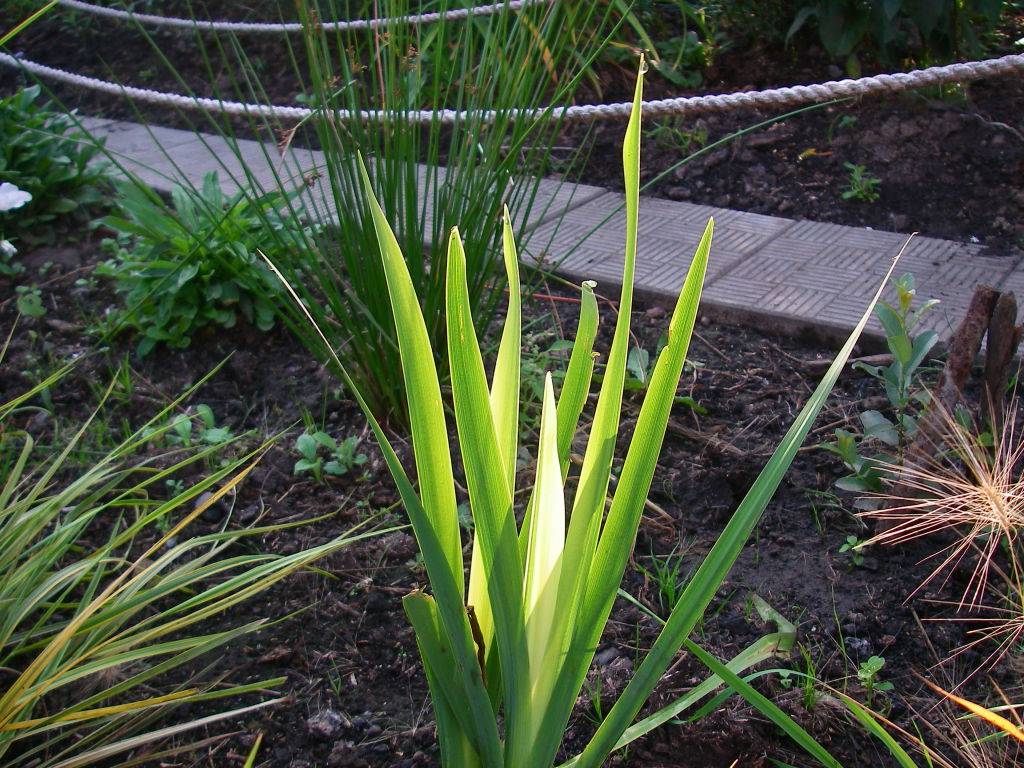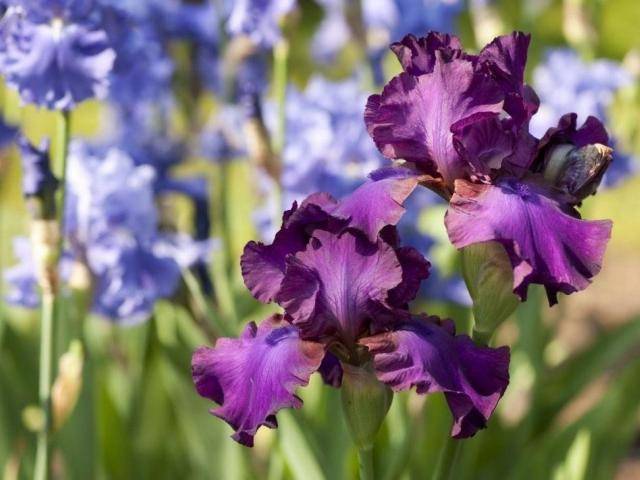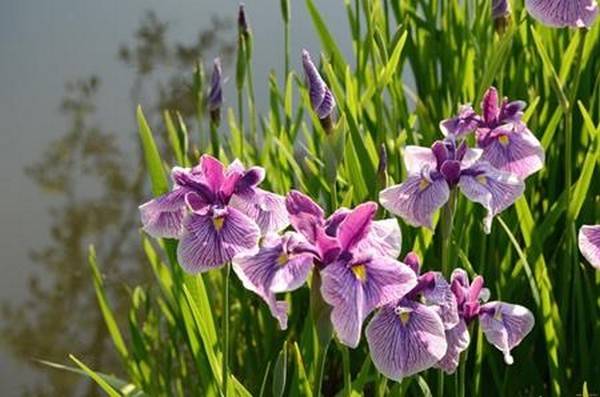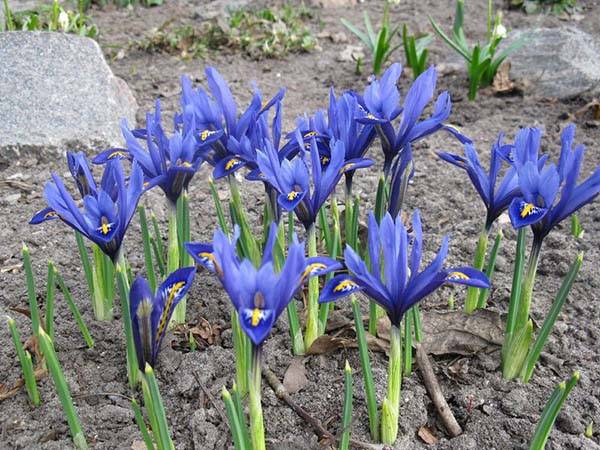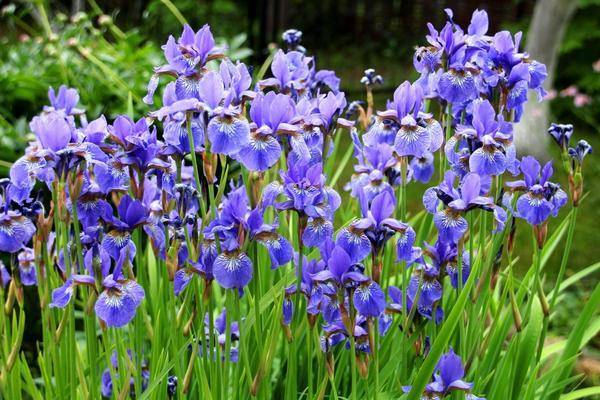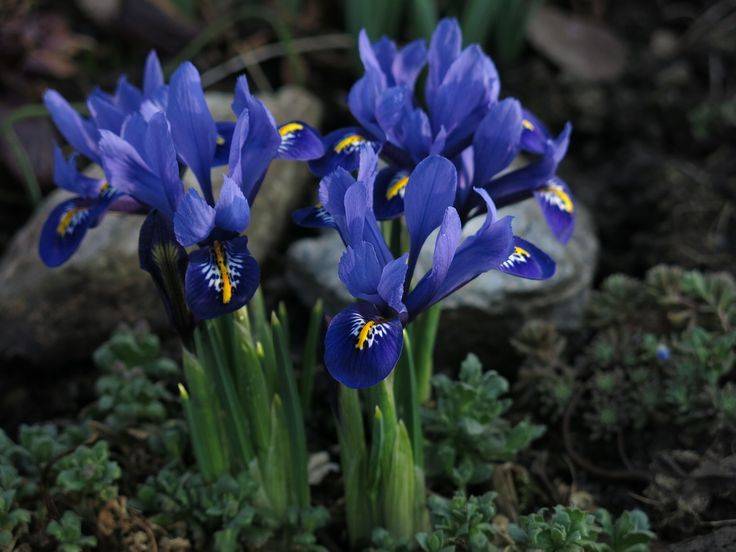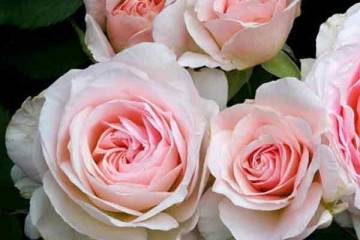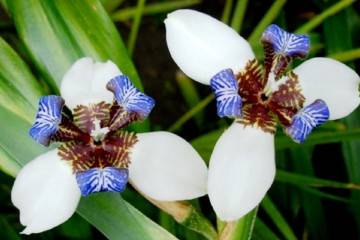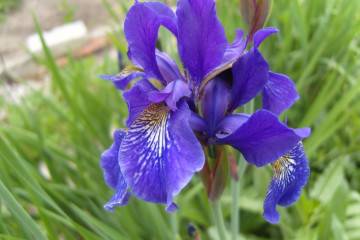Iris marsh, bearded, Japanese, Dutch varietal
Content:
Irises are plants of amazing beauty. They are often used in landscape design to decorate gardens and park areas. Every year new varieties of these flowers appear. One of the reasons is the decorativeness of the plant and the ease of caring for it.
Swamp iris appearance
The flower is unpretentious to care for. It can grow in unfavorable climates, as it has a high degree of resistance to both low temperatures and drought. Another name for it is pseudo-aira iris (in Latin Iris Pseudacorus) or yellow iris. It can be found growing in natural conditions next to water bodies. The growth of adult specimens is different: from 60 cm to 2 m.
The natural way of distribution of marsh iris is by water. Each seed has a cavity filled with air inside. Once on the surface of a river or reservoir, the seeds float until they are planted in a new place of growth. They can also be carried by birds swimming in the water.
The buds are represented by yellow corollas. Below the petals there is a bend, which is pronounced and easy to notice. Up to 15 flowers can bloom on one shrub. The leaf plate is elongated and smooth to the touch.
Iris marsh in landscape design
Iris yellow marsh enlivens any planting site. Most often it is located near water bodies. Used in compound compositions with other plants. It makes a great "hedge". Looks great on flower beds with perennials.
Swamp iris varieties
The most famous and popular varieties:
- black iris got its name due to its color, easy to care for;
- Dyble Pagoda is distinguished by the terry inflorescences, but very insignificant;
- the Umkhir variety is characterized by a pale yellow color of petals with a pink tint;
- Mtskheta was obtained by breeders from Georgia. Its buds are only slightly yellow, can only grow in warm climates;
- for Holden Knough (reticulated iris), an unusual color is inherent: on the yellow petals, a reticulum is visible, which has a purple color;
- Kurlen variety is a hybrid obtained by crossing two natural species. The result is a flower that is 1.5 times the size of a wild flower.
Planting marsh iris
Although the flower can develop in unfavorable conditions, its preferences should be taken into account when planting. Loves open sunny areas, but grows well in partial shade. Undemanding to the composition of the soil. The best option is heavy soil with organic debris. The maximum permissible value of soil acidity is 7.
It tolerates high humidity well. It is not an obstacle to the normal development of the plant. Propagated by seed or vegetative method. In the first variant, the seeds are sown in a pre-moistened soil. Planting time is autumn. No additional steps are required. By spring, sprouts will appear.
With the vegetative method of reproduction, a shoot is cut off at the root and planted in a new place. This can be done both in spring and autumn. To get the greatest survival rate, it is worth planting a flower in this way at the very beginning of March. With this method of reproduction, certain rules should be followed:
- you cannot cut off the shoot during the flowering period;
- all important components must be present on the part to be separated: buds, leaves, stems;
- before planting in a new place, everything is cut off, leaving only a stem 20 cm in size.
Swamp iris care
The plant requires almost no maintenance. It tolerates excess and lack of moisture well. Sometimes it needs fertilization with potassium and phosphorus. May be affected by thrips, sawfly. The diseased parts are removed from the affected plant and sprayed with special agents.
Bearded iris
This hybrid became the foundation for the creation of many new varieties. Breeding work is still actively carried out. The plant differs from the rest in different color shades, just like Dutch iris.
Description of the bearded iris flower
The hybrid bears an outward resemblance to many varieties. Outside the flower petals, there are several beard-like bristles at the top. That's why he got such an interesting name.
All petals are divided into external, directed strictly upward, and internal, falling in the opposite direction, downward. At the pistil, you can see 3 lobes and a supraglottic comb. The stamens are not visible. They are hidden by descending petals and a pistil.
This species includes plants of various sizes. So, dwarf, planted in pots, grow up to 5-10 cm. Their flowers are also small, up to 8 cm in diameter. Tall iris grows above 0.7 m and has flowers of 15-20 cm. Flowering lasts 14 days, from mid-June to early July. The height of medium-sized plants varies between 41-70 cm.
Varieties of bearded iris
All varieties look very elegant, which is why they are often used for making bouquets. There are border varieties. They differ from tall ones in smaller bud size. The color of the flowers is very different, ranging from light shades to very dark:
- Iris Kopatonic is easily recognizable by its rich orange color;
- Nordica - white iris with an orange beard on the petals;
- Intermedia is distinguished by its luxurious June bloom, the size of flowers is 12 cm;
- Iris Xi Xi is decorated with yellow, purple flowers;
These are just some of the varieties that are best known among flower growers.
Planting a bearded iris
The flower prefers neutral or slightly alkaline soil. Suitable, good soil must be moisture permeable. If planting is necessary on heavy soil, sand should be added to dilute.
The most suitable time for planting, reproduction is the end of the flowering period. It is at this moment that the active growth of the root system occurs. It becomes visible on the surface of the soil in the form of compact bumps of light green color. It is necessary to be in time during this period, since later the roots become fragile.
When planting, a hole is formed of such a size that the entire root system can fit. A low mound of earth is made in the center. The plant is placed on it. The root is gently straightened around. Sprinkle with the right amount of earth
Bearded iris care
Water the plant only in severe drought. It is important to remove weeds in a timely manner, sometimes to do pruning. The soil is loosened carefully so as not to damage the roots. Every 3-4 years, the irises are divided and planted, since by this time many dead roots have formed. Dried leaves are usually cut off in the last month of summer.
Bearded iris, planting and leaving in the open field will not take much time and effort, will delight in gratitude with lush flowering and pleasant fragrance. The best time to feed it is after flowering. The plant loves wood ash. Do not over-fertilize with nitrogen in the composition.
Japanese iris
For a long period of time, this variety was little known. Now, thanks to the work of breeders, there are more than 1000 varieties of this plant. It comes from Southeast Asia. Iris can be found naturally in China, Japan, Myanmar. It is customary to grow in high places, as the plant is very beautiful. At higher elevations it looks more impressive.
The variety is characterized by large flowers with a diameter of 15 to 25 cm. Flower composition: perianth, 3 lobes of external and internal petals. The color is found in red, yellow. There are also blue flowers.
Japanese iris varieties
Below are the most popular varieties:
- Vine Raffles is a tall variety, grows up to 1.2 m, decorated with lilac, purple flowers;
- for Cayune Capers, it is worth choosing well-lit areas in the garden. Iris loves sunlight, is characterized by various shades of colors;
- Variegata is grown only in well-drained soil.
Planting Japanese iris
The ideal planting site is partial shade or bright lighting. The soil is neutral or slightly acidified with a small content of calcium in the composition.
Japanese iris care
Up to 3 dressings are made annually, no more. Complex fertilizers are suitable. The plant is good for organic matter. For example, a mullein solution (10%) can be used. The flower grows upward without developing horizontally. For this reason, he needs a mulch cover. For the winter period, the stems are pruned, leaving only a shoot 10-15 cm long. After pruning, a soil mixture enriched with nutrients is added. Cover with a special material.
Bulbous iris
It rightfully belongs to the most delicate and romantic flowers. It resembles a butterfly from the tropics about to take off. Colors (blue, red, burgundy, pink and others) only enhance this impression.
This type is used in gardening when forming flower beds, flower beds. Flowering is short: from late spring to early June. The flowers are painted in bright and colorful tones. The color can be orange, white, purple, blue. Outside on the petals there is a small speck of yellow or orange.
Bulbous iris varieties
There are many varieties of this variety. Here is some of them:
- iris The portal is decorated with blue inflorescences;
- the undersized variety Katarin Hodkin stands out for the difference in color: the flowers are purple on top, the purple patterns similar to strokes are located below, and a yellow spot is located in the center of the petals;
- Dandorf is a variety native to Turkey. The perianth of its bright yellow buds has small green specks.
In total, there are about 800 varieties of this plant.
Planting bulbous iris
For cultivation, the bulbs are planted. They are treated in advance with the help of special agents - fungicides, in order to prevent the appearance and development of a fungus. The planting site should be well lit and the soil should contain nutrients. The right time for planting is early fall.
Bulb iris care
It is necessary to loosen the soil in time, carefully removing the weeds so as not to damage the root system. Shelter is required for the winter. In the spring, mineral fertilizers are applied and again loosened. All dry foliage is removed in autumn.
Siberian iris
The main varietal trait is small flowers. Looks pretty and neat enough. It is frost-resistant, has good immunity.
Depending on the variety, the height of an adult shrub is in the range of 40-160 cm. Flowering begins in early summer. The bloom is luxurious. Duration - 2 weeks.
Planting Siberian iris
Planted in open sunny areas. There is practically no need for drainage, since flowers develop well even at high humidity levels. Digging is recommended before planting. Humus and compost are applied as fertilizer (only after its decomposition).
The depth of the planting pit is no more than 7 cm. This is enough to fit all the roots. It is important to maintain a distance of up to 50 cm between the pits. Immediately after planting, watering and mulching are carried out to retain moisture in the soil.
Siberian iris care
It is rarely watered and at once a lot, since moisture replenishment of the roots along their entire length is required. Complex feeding is introduced in the spring. Propagated by dividing the roots in mid-August.
Dwarf iris
The varieties of this species are distinguished by their miniature size. Dwarf irises are used not only in landscape design (in flower beds or as a border decoration), but also for growing in pots. The plant is obtained by selection method. Many decorative, potted varieties have been created. They make wonderful flower arrangements.
There are 2-3 flowers on the peduncle. The flower looks like medium and tall varieties, only in a reduced version. However, it is even easier to care for and resistant to adverse environmental conditions.
Dwarf iris varieties
The most common varieties:
- Wink 23 cm high blooms with white flowers: inside the bud is snow-white, and outside the petals are blue;
- Puppet has petals of a pale lilac color, the peduncle is decorated with 3 buds up to 9 cm in diameter;
- one of the most beautiful blue irises - Cry Baby is covered with flowers of a sky-blue hue, over time they turn white;
- xiphoid iris grows up to 28 cm;
- cereal iris blooms very beautifully, its flowers are inherent in red, purple color.
Planting a dwarf iris
For planting, you need loose, alkaline or neutral soil. Lime or ash is added to reduce acidity. Good drainage is required so that there is no excess water in the soil. Landing in open ground is carried out from early April to late summer. It is important to dig up the soil before planting and apply fertilizers with 3 main elements: potassium, phosphorus, nitrogen. After planting, cover the ground with mulch.
Dwarf iris care
There are no fundamental differences in the cultivation of dwarf varieties. At the very beginning of spring, nitrogen and potassium are added. After 21 days, the phosphorus and potassium are gradually added. During the flowering period, complex fertilizing is used. Withered buds, leaves are cut off.
A large number of iris species, varieties, hybrids makes it possible to choose "your" flower that best meets the needs of a florist or landscape design specialist. Any iris, even with a short flowering period, can make a garden a corner of paradise on earth.
